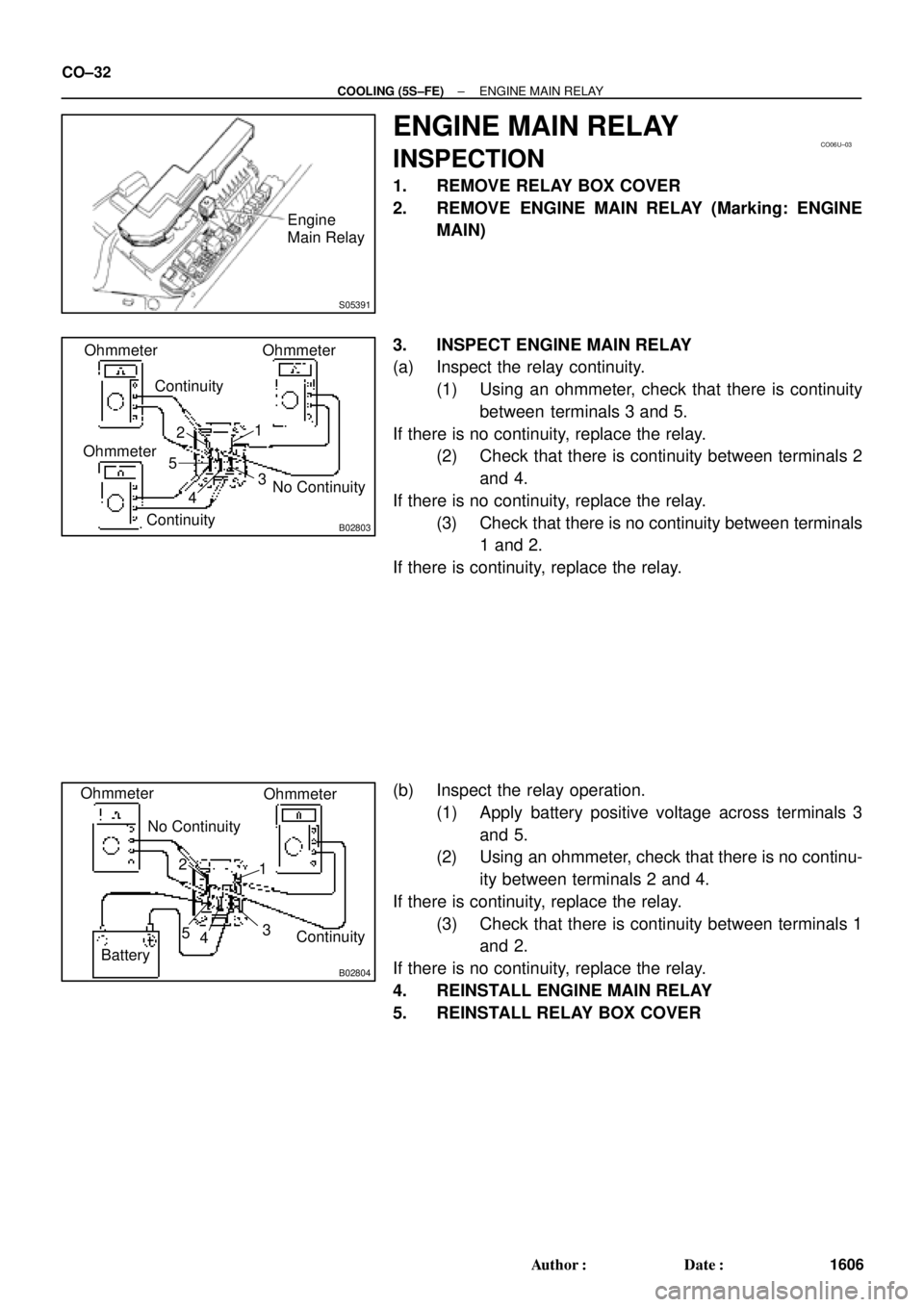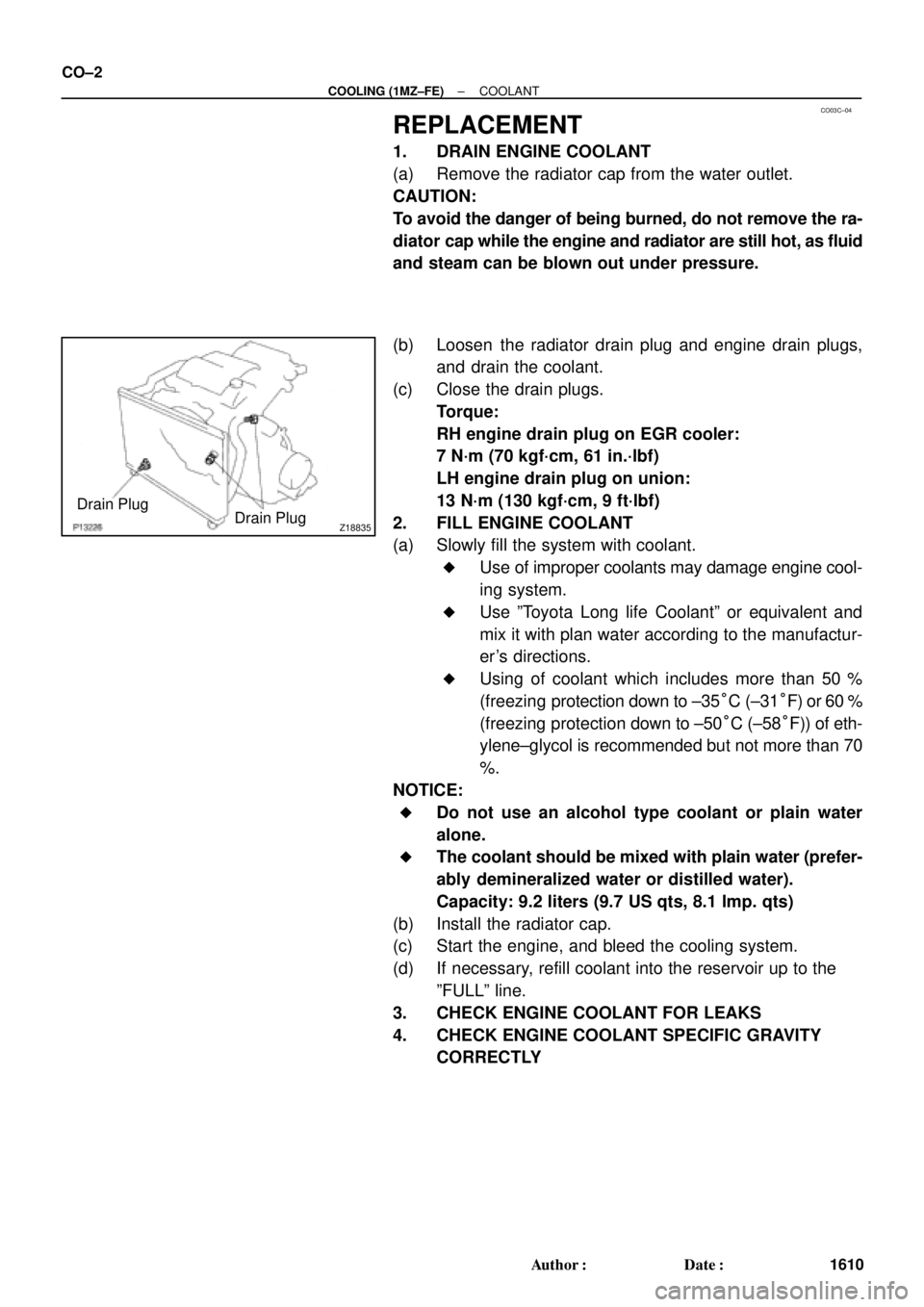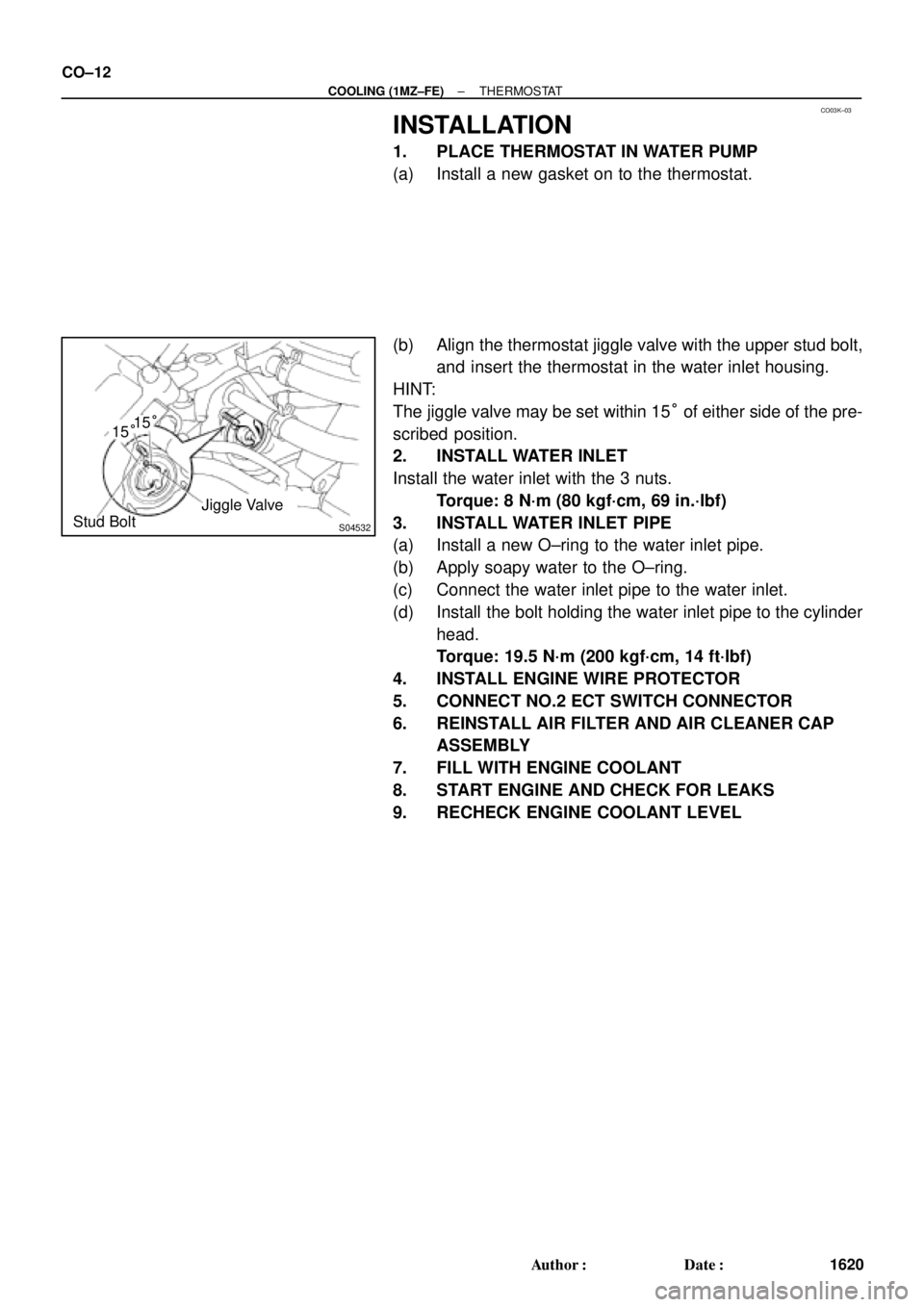Page 2378 of 4770
CO06S±03
S06016Attach
S06017Attach CO±30
± COOLING (5S±FE)ELECTRIC COOLING FAN
1604 Author�: Date�:
INSTALLATION
1. INSTALL NO.1 COOLING FAN
(a) Install the No.1 cooling fan.
(1) Attach the lower side of the cooling fan to the brack-
et of the radiator.
(2) Install the cooling fan with the 2 bolts.
Torque: 5.0 N´m (50 kgf´cm, 44 in.´lbf)
(3) Install the wire and connector holder for the ECT
switch to the fan shroud.
(4) Connect the cooling fan connector.
(5) Connect the ECT switch connector.
(b) Connect the upper radiator hose to the radiator
(c) Fill with engine coolant
(d) Start the engine and check for coolant leaks
2. INSTALL NO.2 COOLING FAN
(a) Attach the lower side of the cooling fan to the bracket of
the radiator.
(b) Install the cooling fan with the 2 bolts.
Torque: 5.0 N´m (50 kgf´cm, 44 in.´lbf)
(c) Connect the cooling fan connector.
Page 2379 of 4770
CO06T±03
S05245
ECT Switch Connector
O±RingECT
Switch
P05962
Ohmmeter
± COOLING (5S±FE)ENGINE COOLANT TEMPERATURE (ECT) SWITCH
CO±31
1605 Author�: Date�:
ENGINE COOLANT
TEMPERATURE (ECT) SWITCH
INSPECTION
1. DRAIN ENGINE COOLANT
2. REMOVE ECT SWITCH
(a) Disconnect the connector.
(b) Remove the ECT switch.
(c) Remove the O±ring from the ECT switch.
3. INSPECT ECT SWITCH
(a) Using an ohmmeter, check that there is no continuity be-
tween the terminals when the coolant temperature is
above 93°C (199°F).
If there is continuity, replace the switch.
(b) Using an ohmmeter, check that there is continuity be-
tween the terminals when the coolant temperature is be-
low 83°C (181°F).
If there is no continuity, replace the switch.
4. REINSTALL ECT SWITCH
(a) Install a new O±ring to the ECT switch.
(b) Install the ECT switch.
(c) Connect the connector.
5. REFILL WITH ENGINE COOLANT
6. START ENGINE AND CHECK FOR COOLANT LEAKS
Page 2380 of 4770

S05391
Engine
Main Relay
CO06U±03
B02803
Ohmmeter
Continuity
OhmmeterOhmmeter
No Continuity
Continuity21
5
43
B02804
Ohmmeter
Ohmmeter
No Continuity
Continuity 2
1
5
43
Battery
CO±32
± COOLING (5S±FE)ENGINE MAIN RELAY
1606 Author�: Date�:
ENGINE MAIN RELAY
INSPECTION
1. REMOVE RELAY BOX COVER
2. REMOVE ENGINE MAIN RELAY (Marking: ENGINE
MAIN)
3. INSPECT ENGINE MAIN RELAY
(a) Inspect the relay continuity.
(1) Using an ohmmeter, check that there is continuity
between terminals 3 and 5.
If there is no continuity, replace the relay.
(2) Check that there is continuity between terminals 2
and 4.
If there is no continuity, replace the relay.
(3) Check that there is no continuity between terminals
1 and 2.
If there is continuity, replace the relay.
(b) Inspect the relay operation.
(1) Apply battery positive voltage across terminals 3
and 5.
(2) Using an ohmmeter, check that there is no continu-
ity between terminals 2 and 4.
If there is continuity, replace the relay.
(3) Check that there is continuity between terminals 1
and 2.
If there is no continuity, replace the relay.
4. REINSTALL ENGINE MAIN RELAY
5. REINSTALL RELAY BOX COVER
Page 2383 of 4770
CO03B±04
± COOLING (1MZ±FE)COOLANT
CO±1
1609 Author�: Date�:
COOLANT
INSPECTION
1. CHECK ENGINE COOLANT LEVEL AT RADIATOR RESERVOIR
The engine coolant level should be between the ºLOWº and ºFULLº lines, when the engine is cold.
If low, check for leaks and add ''Toyota Long Life Coolantº or Equivalent up to the ºFULLº line.
2. CHECK ENGINE COOLANT QUALITY
(a) Remove the radiator cap from the water outlet.
CAUTION:
To avoid the danger of being burned, do not remove the radiator cap while the engine and radiator
are still hot, as fluid and steam can be blown out under pressure.
(b) There should not be any excessive deposits of rust or scale around the radiator cap or water outlet
filler hole, and the coolant should be free from oil.
If excessively dirty, clean the coolant passages and replace the coolant.
(c) Reinstall the radiator cap.
Page 2384 of 4770

CO03C±04
Z18835
Drain Plug
Drain Plug CO±2
± COOLING (1MZ±FE)COOLANT
1610 Author�: Date�:
REPLACEMENT
1. DRAIN ENGINE COOLANT
(a) Remove the radiator cap from the water outlet.
CAUTION:
To avoid the danger of being burned, do not remove the ra-
diator cap while the engine and radiator are still hot, as fluid
and steam can be blown out under pressure.
(b) Loosen the radiator drain plug and engine drain plugs,
and drain the coolant.
(c) Close the drain plugs.
Torque:
RH engine drain plug on EGR cooler:
7 N´m (70 kgf´cm, 61 in.´lbf)
LH engine drain plug on union:
13 N´m (130 kgf´cm, 9 ft´lbf)
2. FILL ENGINE COOLANT
(a) Slowly fill the system with coolant.
�Use of improper coolants may damage engine cool-
ing system.
�Use ºToyota Long life Coolantº or equivalent and
mix it with plan water according to the manufactur-
er's directions.
�Using of coolant which includes more than 50 %
(freezing protection down to ±35°C (±31°F) or 60 %
(freezing protection down to ±50°C (±58°F)) of eth-
ylene±glycol is recommended but not more than 70
%.
NOTICE:
�Do not use an alcohol type coolant or plain water
alone.
�The coolant should be mixed with plain water (prefer-
ably demineralized water or distilled water).
Capacity: 9.2 liters (9.7 US qts, 8.1 lmp. qts)
(b) Install the radiator cap.
(c) Start the engine, and bleed the cooling system.
(d) If necessary, refill coolant into the reservoir up to the
ºFULLº line.
3. CHECK ENGINE COOLANT FOR LEAKS
4. CHECK ENGINE COOLANT SPECIFIC GRAVITY
CORRECTLY
Page 2390 of 4770
CO0SO±01
P12942
CO±8
± COOLING (1MZ±FE)WATER PUMP
1616 Author�: Date�:
INSTALLATION
1. INSTALL WATER PUMP
Install a new gasket and the water pump with the 4 bolts and 2
nuts.
Torque: 8 N´m (80 kgf´cm, 69 in.´lbf)
NOTICE:
Do not get oil on the gasket.
2. INSTALL NO.3 TIMING BELT COVER
(See page EM±57)
3. INSTALL NO.2 IDLER PULLEY
(See page EM±21)
4. INSTALL CAMSHAFT TIMING PULLEYS
(See page EM±21)
5. INSTALL TIMING BELT
(See page EM±21)
6. FILL WITH ENGINE COOLANT
7. START ENGINE AND CHECK FOR LEAKS
8. RECHECK ENGINE COOLANT LEVEL
Page 2394 of 4770

CO03K±03
S04532
Jiggle Valve
Stud Bolt15°15° CO±12
± COOLING (1MZ±FE)THERMOSTAT
1620 Author�: Date�:
INSTALLATION
1. PLACE THERMOSTAT IN WATER PUMP
(a) Install a new gasket on to the thermostat.
(b) Align the thermostat jiggle valve with the upper stud bolt,
and insert the thermostat in the water inlet housing.
HINT:
The jiggle valve may be set within 15° of either side of the pre-
scribed position.
2. INSTALL WATER INLET
Install the water inlet with the 3 nuts.
Torque: 8 N´m (80 kgf´cm, 69 in.´lbf)
3. INSTALL WATER INLET PIPE
(a) Install a new O±ring to the water inlet pipe.
(b) Apply soapy water to the O±ring.
(c) Connect the water inlet pipe to the water inlet.
(d) Install the bolt holding the water inlet pipe to the cylinder
head.
Torque: 19.5 N´m (200 kgf´cm, 14 ft´lbf)
4. INSTALL ENGINE WIRE PROTECTOR
5. CONNECT NO.2 ECT SWITCH CONNECTOR
6. REINSTALL AIR FILTER AND AIR CLEANER CAP
ASSEMBLY
7. FILL WITH ENGINE COOLANT
8. START ENGINE AND CHECK FOR LEAKS
9. RECHECK ENGINE COOLANT LEVEL
Page 2396 of 4770

CO03M±03
Z00570
Radiator Cap Tester
30° or More
Radiator Cap
CO±14
± COOLING (1MZ±FE)RADIATOR
1622 Author�: Date�:
ON±VEHICLE INSPECTION
1. REMOVE RADIATOR CAP
CAUTION:
To avoid the danger of being burned, do not remove the ra-
diator cap while the engine and radiator are still hot, as fluid
and steam can be blow out under pressure.
2. INSPECT RADIATOR CAP
NOTICE:
�If the radiator cap has contaminations, always rinse
it with water.
�When performing steps (a) and (b) below, keep the ra-
diator cap tester at an angle of over 30° above the hor-
izontal.
�Before using a radiator cap tester, wet the relief valve
and pressure valve with engine coolant or water.
(a) Using a radiator cap tester, slowly pump the tester and
check that air is coming from the vacuum valve.
Pump speed: 1 push/(3 seconds or more)
NOTICE:
Push the pump at a constant speed.
If air is not coming from the vacuum valve, replace the radiator
cap.
(b) Pump the tester and measure the relief valve opening
pressure.
Pump speed: 1 push within 1 second
NOTICE:
This pump speed is for the first pump only (in order to close
the vacuum valve). After this, the pump speed can be re-
duced.
Standard opening pressure:
83 ± 113 kPa (0.85 ± 1.15 kgf/cm
2, 12.1 ± 16.4 psi)
Minimum opening pressure:
69 kPa (0.7 kgf/cm
2, 10.0 psi)
HINT:
Use the tester's maximum reading as the opening pressure.
If the opening pressure is less than minimum, replace the radia-
tor cap.